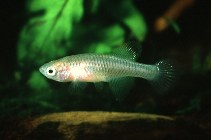
|
Nothobranchius vosseleri Ahl, 1924 Pangani nothobranch |

|
|
photo by
Seegers, L. |
| Family: | Nothobranchiidae (African rivulines) | |||
| Max. size: | 4.46 cm SL (male/unsexed) | |||
| Environment: | benthopelagic; freshwater; pH range: 7.5 - 8.3, non-migratory | |||
| Distribution: | Africa: Pangani River basin, Tanzania (Ref. 96650). | |||
| Diagnosis: | Dorsal spines (total): 0-0; Dorsal soft rays (total): 14-16; Anal spines: 0-0; Anal soft rays: 15-18. Diagnosis: Nothobranchius vosseleri is a member of a group of Nothobranchius species of relatively large size and with a slender body, less than 30% of standard length, compared to other species of the genus; and a distinct red caudal fin in male (Ref. 96650). It can be distinguished from other species of the so-called N. melanospilus group by a pointed snout, and the presence of a dark vertical bar through the iris (Ref. 96650). Description: Nothobranchius of medium size with distinctly pointed snout; mouth wide, directed upward (Ref. 96650). Dorsal-fin origin above or just behind origin of anal fin and behind mid-length of body; dorsal fin with 14-16 rays, anal fin with 15-18 rays (Ref. 96650). Scales on mid-longitudinal line 25-31+3-4 on caudal fin, most with a shallow pit in center, not connected to an underlying neuromast system; transverse rows of scales above pelvic fins 10-11; transverse rows of scales on caudal peduncle 6-7 (Ref. 96650). Anterior and central supraorbital neuromast systems separated and consisting of two shallow grooves, lined with low lobes; cephalic squamation irregular, not representing any pattern, and anteriorly covered by epidermal tissue; posterior supraorbital neuromast systems strongly curved, but less than 90; preopercular neuromast system in an open groove, distal end not overlapping operculum (Ref. 96650). | |||
| Biology: | Nothobranchius vosseleri was observed from a wide variety of habitats, including ephemeral pools, temporary creeks, man-made ditches and small, probably permanent, streams; bordering vegetation of grasses and stands of Typha and Cyperus were found at all localities (Ref. 96650). It is an annual species, its annual reproduction was confirmed in the aquarium; eggs are, after a short courtship, deposited in the bottom substrate, which is mainly silt with an addition of decayed plant material (Ref. 96650). Like all other known Nothobranchius species, the eggs survive the dry season by delayed hatching; the majority of eggs are hatchable 8 to 10 weeks after spawning; growth is fast, after 6 to 7 weeks of age the young fishes may reproduce (Ref. 96650). | |||
| IUCN Red List Status: | Vulnerable (VU); Date assessed: 12 January 2019 (B1ab(iii)) Ref. (130435) | |||
| Threat to humans: | harmless | |||